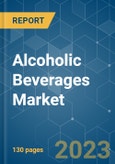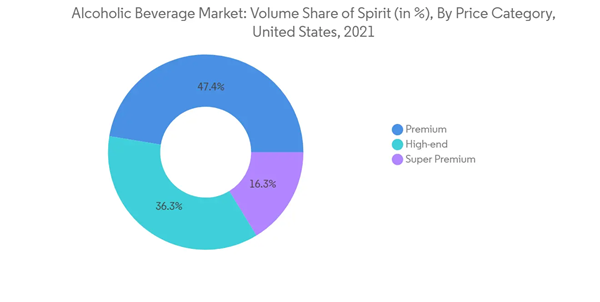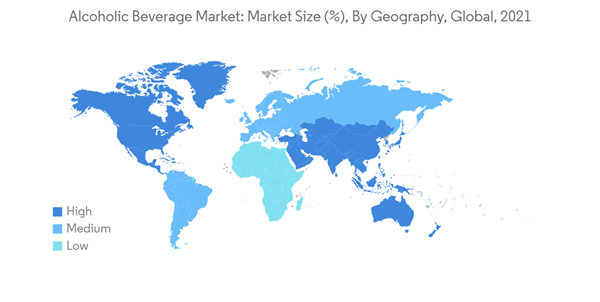The alcoholic beverages market is expected to register a CAGR of 3.4% during the forecast period.
The global alcoholic beverages market is growing due to the increasing youth population, rising middle-class income, and a strong economy. The rising consumer demand for new variants, in the case of alcohol, has created a revolution in craft beer formulation. Many breweries have chosen to develop newer product varieties with the required characteristics, thereby formulating mild-lager beer for consumers. To cater to the upsurge in market demand, the production of craft beer in different global and regional breweries has increased significantly. For instance, according to the US Brewers Association, in 2021, 65.7% of craft beer production in the United States took place in regional breweries. The increase in the number of microbreweries has also increased the production of craft beer in the market. In 2021, 18.4% of craft beer in the United States was crafted in local microbreweries.
The market is likely to be driven by the increasing global young-adult demographic, coupled with high disposable income and consumer demand for premium/super-premium products. Globally, beer drives the market for alcoholic beverages. Regionally, North America and Asia-Pacific are expected to dominate the market during the forecast period. In the market studied, growth in online retailing has been observed. In the past few years, Drizly, an alcohol e-commerce platform, experienced revenue growth in online alcohol delivery.
During the COVID-19 outbreak, the alcoholic beverages market was severely impacted by the closure of specialty shops, bars, pubs, and restaurants. During mid-2020, the easing of lockdown measures led retailers to gain confidence. At the same time, a steep increase in prices was observed in some countries, mostly due to government regulations and taxes, thus minimally affecting the market studied. For instance, on March 24, 2020, Pernod Ricard revised its outlook for the current fiscal year and expected its profit margins to decline by nearly 20%, mainly due to the spread of COVID-19. Companies also witnessed a surge in their off-premise sales compared to on-premise sales. For instance, Constellations Brands saw a 30% rise in its beer volume in the US off-premise channel in February 2020, as the customers avoided on-premise to stem the spread of COVID-19. The demand for hard drinks, such as whiskey and gin, grew during the pandemic, while beer witnessed volume growth. In-house consumption, along with the stocking of brands, has been one of the driving factors of the market to sustain during the pandemic.
The increased health consciousness of consumers has boosted the demand for premium alcoholic beverages in an effort to avoid alcohol poisoning, which is caused by consuming inadequate alcohol. This rise in health awareness has resulted in the creation of functional premium alcoholic beverages. The inclusion of different natural and exotic ingredients in alcohol tends to improve its functional properties, thereby gaining attention from a larger set of customers. For instance, in March 2022, Whitley Neill, a premium gin brand in the United Kingdom, launched a new gin variant, namely, Oriental Spiced Gin. This gin consists of different botanicals and spices like coriander, ginger, chili, cumin, saffron, star anise, and grains of paradise.
Therefore, the rising popularity of premium and super-premium alcoholic beverages is expected to drive market demand during the forecast period.
The US wine market is being catered to by more than 10,000 wineries, with California holding the highest share, i.e., more than 85%, followed by Washington, Oregon, New York, Texas, and Virginia. American consumers are becoming more attracted to wines with descriptors such as no taste additives, gluten-free, low carb, vegan-friendly, sulfite-free, low calorie, low alcohol, light, lighter, organic, paleo-friendly, etc. This popularity is attributable to the rising focus on healthy food and beverages across the country.
This product will be delivered within 2 business days.
The global alcoholic beverages market is growing due to the increasing youth population, rising middle-class income, and a strong economy. The rising consumer demand for new variants, in the case of alcohol, has created a revolution in craft beer formulation. Many breweries have chosen to develop newer product varieties with the required characteristics, thereby formulating mild-lager beer for consumers. To cater to the upsurge in market demand, the production of craft beer in different global and regional breweries has increased significantly. For instance, according to the US Brewers Association, in 2021, 65.7% of craft beer production in the United States took place in regional breweries. The increase in the number of microbreweries has also increased the production of craft beer in the market. In 2021, 18.4% of craft beer in the United States was crafted in local microbreweries.
The market is likely to be driven by the increasing global young-adult demographic, coupled with high disposable income and consumer demand for premium/super-premium products. Globally, beer drives the market for alcoholic beverages. Regionally, North America and Asia-Pacific are expected to dominate the market during the forecast period. In the market studied, growth in online retailing has been observed. In the past few years, Drizly, an alcohol e-commerce platform, experienced revenue growth in online alcohol delivery.
During the COVID-19 outbreak, the alcoholic beverages market was severely impacted by the closure of specialty shops, bars, pubs, and restaurants. During mid-2020, the easing of lockdown measures led retailers to gain confidence. At the same time, a steep increase in prices was observed in some countries, mostly due to government regulations and taxes, thus minimally affecting the market studied. For instance, on March 24, 2020, Pernod Ricard revised its outlook for the current fiscal year and expected its profit margins to decline by nearly 20%, mainly due to the spread of COVID-19. Companies also witnessed a surge in their off-premise sales compared to on-premise sales. For instance, Constellations Brands saw a 30% rise in its beer volume in the US off-premise channel in February 2020, as the customers avoided on-premise to stem the spread of COVID-19. The demand for hard drinks, such as whiskey and gin, grew during the pandemic, while beer witnessed volume growth. In-house consumption, along with the stocking of brands, has been one of the driving factors of the market to sustain during the pandemic.
Alcoholic Beverages Market Trends
Premiumization is Driving the Market
Consumers worldwide have a more sophisticated palate now. They are always looking for distinctive and high-quality alcoholic beverages. This has increased the demand for premium-quality alcoholic beverages in the market. According to Distilled Spirits Council of the United States, in 2021, 21.7 million 9-liter cases of premium whiskey and 21.1 million 9-liter cases of premium vodka were consumed. Also, the year-on-year growth rate for super-premium whiskey and vodka accounted for 14.1% and 13.9%, respectively.The increased health consciousness of consumers has boosted the demand for premium alcoholic beverages in an effort to avoid alcohol poisoning, which is caused by consuming inadequate alcohol. This rise in health awareness has resulted in the creation of functional premium alcoholic beverages. The inclusion of different natural and exotic ingredients in alcohol tends to improve its functional properties, thereby gaining attention from a larger set of customers. For instance, in March 2022, Whitley Neill, a premium gin brand in the United Kingdom, launched a new gin variant, namely, Oriental Spiced Gin. This gin consists of different botanicals and spices like coriander, ginger, chili, cumin, saffron, star anise, and grains of paradise.
Therefore, the rising popularity of premium and super-premium alcoholic beverages is expected to drive market demand during the forecast period.
North America Holds the Significant Market Share
North America dominates the alcoholic beverage industry due to the high portion of the young adult population. The rising demand for high-quality alcoholic drinks is expected to boost the alcoholic beverages market over the forecast period. The North American alcohol market is anticipated to grow dramatically due to the increased disposable income. Developing countries are expected to drive the region's alcoholic beverage industry in the coming years. Craft beer and craft spirits are the fastest-growing segments due to the consumer perception of craft spirits as premium quality and the concept of mindful drinking in the country.The US wine market is being catered to by more than 10,000 wineries, with California holding the highest share, i.e., more than 85%, followed by Washington, Oregon, New York, Texas, and Virginia. American consumers are becoming more attracted to wines with descriptors such as no taste additives, gluten-free, low carb, vegan-friendly, sulfite-free, low calorie, low alcohol, light, lighter, organic, paleo-friendly, etc. This popularity is attributable to the rising focus on healthy food and beverages across the country.
Alcoholic Beverages Market Competitor Analysis
The market is highly competitive, and major players account for significant shares in the market. Some of the largest market players in the alcoholic beverages market are Diageo, Anheuser-Busch InBev, Heineken Holding NV, Bacardi Limited, and Constellation Brands. The players in the alcoholic beverages market use various strategies in order to increase their sales. These strategies include mergers and acquisitions, partnerships, and product innovations. For instance, in June 2021, Diageo India announced its debut in craft whisky with United’s Epitome Reserve. Epitome Reserve is a small-batch, artisanal craft, 100% rice whisky. This limited edition whisky was only released in a batch of 2,000 numbered bottles.Additional benefits of purchasing the report:
- The market estimate (ME) sheet in Excel format
- 3 months of analyst support
This product will be delivered within 2 business days.
Table of Contents
1 INTRODUCTION
4 MARKET DYNAMICS
5 MARKET SEGMENTATION
6 COMPETITIVE LANDSCAPE
Companies Mentioned (Partial List)
A selection of companies mentioned in this report includes, but is not limited to:
- Diageo PLC
- Bacardi Limited
- Constellation Brands Inc.
- Anheuser-Busch InBev
- Heineken Holding NV
- Molson Coors Brewing Company
- Boston Beer Company Inc.
- Asahi Group Holdings Ltd
- Carlsberg Group
- Suntory Beverage & Food Limited
Methodology

LOADING...










